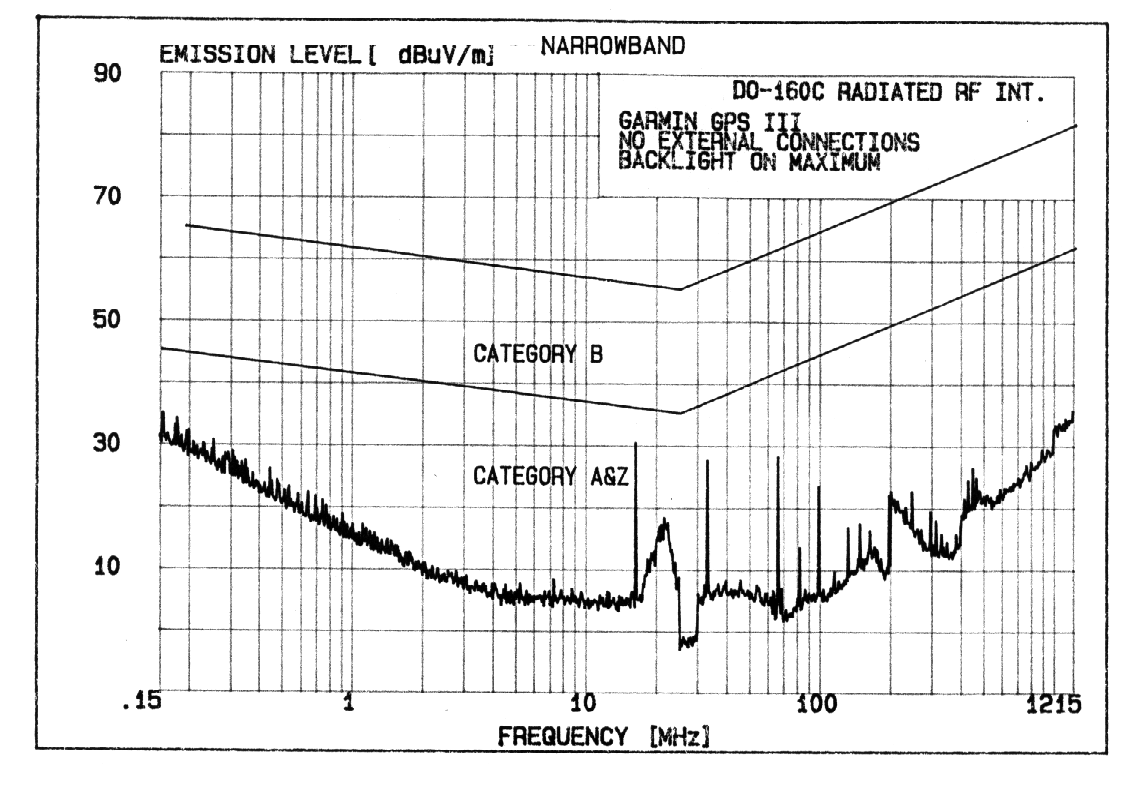
Garmin G-III GPS radiated EMI levels vs DO-160C specification
He wishes not to have his name published, but if there are questions
I will be happy to forward them for possible reply.
Joe Mehaffey
-----------------------------------------------------------------
The unit was setup in a shielded enclosure, about 2 inches above a ground plane. Since no cables were connected to the unit, the Conducted Emissions test did not apply. The measurement was made with the unit operating with the backlight on fully, although no difference in emissions was seen with the backlight off. The normal antenna was connected, and since the unit was in a shielded enclosure no satellites were tracked. Also since I've never bothered to upgrade the software from v2.03, the power saver mode of later versions could not have been used.
DO-160C Category Z is what most avionics equipment recently designed is generally certified to. A successor standard DO-160D is in the works or possibly recently required for newly-designed equipment. I have seen a draft standard DO-160D which has a category M is described as suitable for "equipment .. located in the passenger cabin ... of a transport aircraft". Category M at least in the DO-160D draft I've seen is similar to DO-160C category Z with certain differences. It reduces the acceptable level to 34 dB between 100 and 150 MHz. It also extends the measurement to 6 GHz at the same slope with notches to 50 dB between 1020 and 1100 MHz and to 53 dB between 1525 and 1680 MHz. Broadband measurements are not made under DO-160D.
The test results show that my Garmin III meets DO-160C category Z and also the draft DO-160D category M for at least the spectrum below 1215 MHz. Most of what is seen in the graph is the background noise in the spectrum analyzer used to make the measurement, with the spikes being the emissions from the G3. My guess is that they correspond to the processor clock and its harmonics.
While the results are impressive, here are some things to consider:
- These results apply only to my unit. It is possible
that Garmin has made design changes during the production life of the product
that makes it emit more (or less) than my sample..
- During my measurement, the unit was in a shielded chamber
and therefore not tracking any satellites. I Don't know if this makes
any difference.
- The measured spectrum stops at 1215 MHz. But if it
doesn't interfere with another nearby GPS receiver then it probably won't
interfere with the aircraft's GPS system while inside the fuselage.
- The measurement was made as a standalone unit -- no cables
were connected such as to a laptop. Also the normal antenna configuration
was used.
The graph below shows the radiated emissions spectrum recorded by the spectrum analyzer for my G-III unit.

Garmin G-III GPS radiated EMI levels vs DO-160C specification